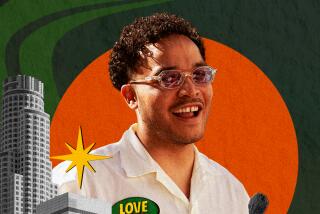West Meets East in La Habra : Children’s Museum ‘Passport to Asia’ Show Orients Grade-Schoolers to Different Cultures
A Vietnamese farmer and a Japanese nobleman play tag, while across the room a pair of Chinese schoolgirls collapse into giggles over their rice bowls.
No, this isn’t an Asian summit gone awry. It’s just business as usual at “Passport to Asia,” a hands-on exhibit at the La Habra Children’s Museum. Designed for children in grades K-6, the show continues through March 24.
Through a series of mostly participatory displays, “Passport to Asia” introduces kids to the customs and cultures of China, Japan and Vietnam. They can don kimonos and tabis (split-toe socks), count on an abacus, fold origami souvenirs and try to master the use of chopsticks. A gallery assistant is available to answer questions, and each weekday the museum offers eight group tours, including stops at the nature room, the historical train exhibit and the new theater and science galleries.
Judging from recent visitors such as a second-grade class from La Palma’s Ladera Palma school, “Passport to Asia” is an eye-opening experience for most grade-schoolers. Squirming in line as they waited for their tour guide, students were excited about the show, but a little foggy on its content.
“Japan? It’s, um, way over there,” guessed 8-year-old Patrick Halstead, gesturing vaguely as he directed an elbow at a classmate’s ribs.
Dallas George, 7, was more confident: “Vietnam is down by China, right? I know because my dad was there.”
As the tour began, docent Carrie Wictor cleared up the question with a quick geography lesson, then moved on to an audience-participation fashion show. Selecting Patrick and 7-year-old Kandice Ludwick as her models, Wictor gave many of the kids their first look at traditional Asian costumes.
“A kimono is a little bit like a bathrobe, but it’s special,” Wictor explained, wrapping the freckled girl in a red floral number that billowed over the girl’s cowboy boots. Over his T-shirt and jeans, Patrick modeled a short cotton kimono and a white headband with a crimson rising sun.
Then it was time for show-and-tell as Wictor pointed out a doll dressed in a traditional Vietnamese ao dai (a dress-like garment with split sides worn over flowing pants); a photo display on the art of jade and ivory carving; the tea ceremony and bonsai; and a collection of abacuses and soroban--ancient Asian counting tools that Wictor compared to an electronic calculator.
Standing beneath several colorful koi-fish kites, the youngsters learned of Japan’s celebration of Children’s Day, May 5. The kites, explained Wictor, are traditional Children’s Day gifts for boys and are flown outside their homes that day. To remind them to be strong and brave, young men also receive a miniature samurai helmet, Wictor said. The girls in the visiting class enjoyed a collection of elegant Empress dolls, the traditional Children’s Day gift for young women.
Outfitted with these facts and figures, the kids were ready for some hands-on learning. Wictor conducted a workshop in the art of origami--decorative paper-folding--while several youngsters grappled with chopsticks, attempting with varying degrees of success to scoop cotton-ball “rice” from their bowls. Laughing at her fumbling fingers, Carly Moegling, 8, decided that although chopsticks were “weird, but fun,” given the choice, she’d take a spoon.
At the clothing display, the grade-schoolers were happily mixing cultures and costumes, topping off Japanese kimonos and geta (wooden “platform” shoes) with Vietnamese sun hats and Chinese parasols.
Seven-year-old Adam Wheeler looked particularly regal, sweeping past his classmates in a dark kimono with a trailing hem.
“What do you call these things--cocoons? Oh yeah, kimonos,” said Wheeler, waving his capacious sleeves. “It’d be cool to dress like this, especially when it’s hot.”
The La Habra Children’s Museum has supplemented “Passport to Asia” with a series of Asian-themed workshops and performances. Upcoming events include a March 17 show by the Nosho Miyagi Dancers, performing dances from the Okinawa region, and, on March 24, Chinese folk songs by the Little Panda Chorus, a children’s choir. All shows are free with paid admission to the museum. “Passport to Asia,” which opened Jan. 15, is one of several changing exhibits scheduled this year at the museum.
“Passport to Asia” continues through March 24 at the La Habra Children’s Museum, 301 S. Euclid St., La Habra. Hours are Monday through Saturday, 10 a.m. to 4 p.m. Admission is $1.50 for children and seniors, $2 for adults. Tours, available to groups of 10 or more, must be scheduled in advance. For information, call (213) 905-9793.
More to Read
The biggest entertainment stories
Get our big stories about Hollywood, film, television, music, arts, culture and more right in your inbox as soon as they publish.
You may occasionally receive promotional content from the Los Angeles Times.










